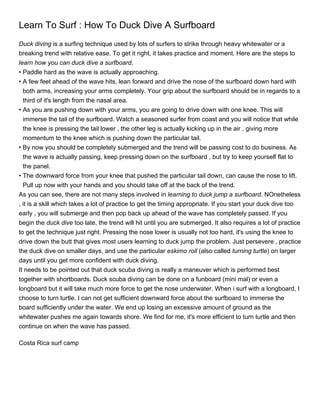
Learn To Surf _ How To Duck Dive A Surfboard
- 1. Learn To Surf : How To Duck Dive A Surfboard Duck diving is a surfing technique used by lots of surfers to strike through heavy whitewater or a breaking trend with relative ease. To get it right, it takes practice and moment. Here are the steps to learn how you can duck dive a surfboard. • Paddle hard as the wave is actually approaching. • A few feet ahead of the wave hits, lean forward and drive the nose of the surfboard down hard with both arms, increasing your arms completely. Your grip about the surfboard should be in regards to a third of it's length from the nasal area. • As you are pushing down with your arms, you are going to drive down with one knee. This will immerse the tail of the surfboard. Watch a seasoned surfer from coast and you will notice that while the knee is pressing the tail lower , the other leg is actually kicking up in the air , giving more momentum to the knee which is pushing down the particular tail. • By now you should be completely submerged and the trend will be passing cost to do business. As the wave is actually passing, keep pressing down on the surfboard , but try to keep yourself flat to the panel. • The downward force from your knee that pushed the particular tail down, can cause the nose to lift. Pull up now with your hands and you should take off at the back of the trend. As you can see, there are not many steps involved in learning to duck jump a surfboard. NOnetheless , it is a skill which takes a lot of practice to get the timing appropriate. If you start your duck dive too early , you will submerge and then pop back up ahead of the wave has completely passed. If you begin the duck dive too late, the trend will hit until you are submerged. It also requires a lot of practice to get the technique just right. Pressing the nose lower is usually not too hard, it's using the knee to drive down the butt that gives most users learning to duck jump the problem. Just persevere , practice the duck dive on smaller days, and use the particular eskimo roll (also called turning turtle) on larger days until you get more confident with duck diving. It needs to be pointed out that duck scuba diving is really a maneuver which is performed best together with shortboards. Duck scuba diving can be done on a funboard (mini mal) or even a longboard but it will take much more force to get the nose underwater. When i surf with a longboard, I choose to turn turtle. I can not get sufficient downward force about the surfboard to immerse the board sufficiently under the water. We end up losing an excessive amount of ground as the whitewater pushes me again towards shore. We find for me, it's more efficient to turn turtle and then continue on when the wave has passed. Costa Rica surf camp